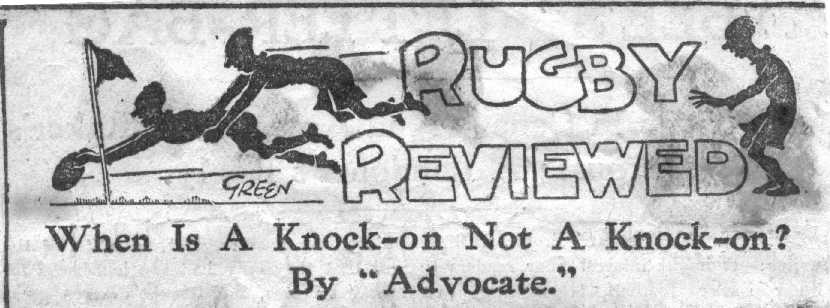

RUGBY REVIEWED
When
Is A Knock-on Not A Knock on ?
A club official of long experience, who has done a considerable amount of refereeing and who is a very critical observer of differences in interpretation of rules, has asked me to put forward a plea for the establishment of a more definite ruling as to what constitutes a "knock-on.’’ In the laws of the game, part 1, law 2, the following appears: "Knock-on or throw forward is the propulsion of the ball by hand or arm of a player in the direction of his opponents' dead ball line," and in a later place, "A rebound is not a knock-on." In Notes for Referees, 1927-28, the London Referees' Society has the following instruction, "A slight fumble by the player in catching the ball must not be considered a knock-on, provided he does not lose control of it."
The club official who had raised the question contends that there is such wide difference in the opinion of referees as to what does or does not constitute a knock-on that it would be better if the controlling official was deprived of the onus of judgement in this matter by the definite ruling, either that the ball must be taken cleanly at the first attempt, or that the game should be allowed to proceed as long as the player who fumbles is able to gather the ball before it touches the ground. Each of the three alternatives has its own peculiar advantages. To keep to the literal interpretation of the definition is to impress upon the player the necessity for sure handling, and put a premium upon clean passing and gathering of the ball. To give further licence by allowing the ball to be gathered after being propelled well forward would reduce the number of checks and speed up the game to some extent. The intermediate course would be ideal were it not that it depends on simple sounding terms which are by no means easy to define. What is "a slight fumble ? When does a player lose control of the ball ?" Some will say that control is lost when the ball is no longer gripped by the hands, others will contend that the fact that a player ultimately gathers the ball is sufficient evidence of control even in the absence of contact with any part of the body.
If all referees were of the standard set in representative and senior club games, there would be a very strong case for the retention of the "slight fumble," or "under control" definition. Unfortunately they are not, and young players experience such varying decisions in successive weeks that they are left in a state of bewilderment. To the other two alternatives there are distinct drawbacks which cannot be overlooked. Very few passes, particularly in bad weather, are taken so cleanly at the first attempt that the hypercritical could not find some slight fault with them. The all allowed definition would probably increase the slovenliness in handling already much too common in many quarters, and would tend to increase carelessness, not only in the taking, but in the giving of passes. The knock-on, and the advantage rule, which I shall discuss next week, are matters which might well be given consideration by various referees' societies. It would, I feel, be a good thing for the control of the game, if the societies introduced two types of membership- ordinary, for those taking club games under the society's instructions, and associate, those taking second and third team games on request of their clubs, the latter not coming under the society's call, but having the right to receive all publications and circulars, and to be present at meetings, with or without, as might be found advisable, the right to vote.
("Advocate" was none other than W.B.Croxford)